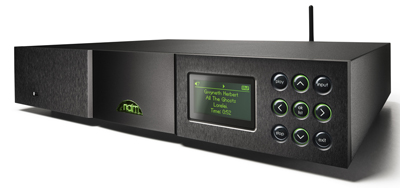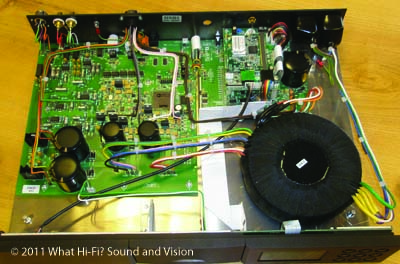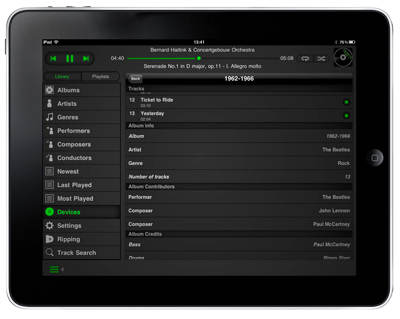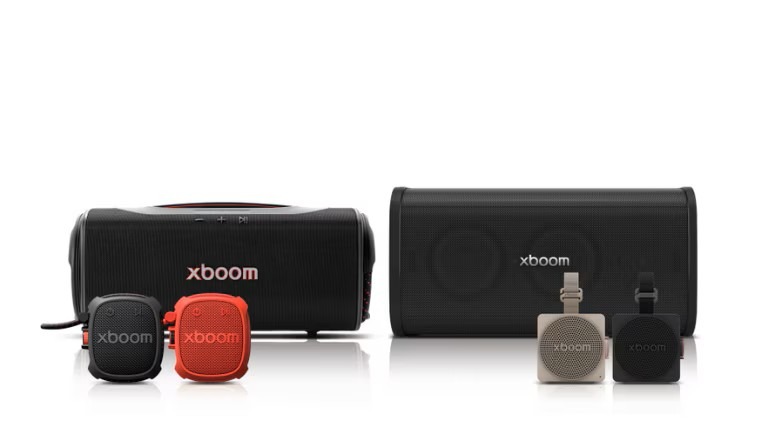Full stream ahead: hands-on with Naim’s NDX network player

After more than two months with Naim’s upmarket streaming client, I’m finally sure that ‘digits is digits’ is baloney
If they’re not careful, some of those who advocate consigning all your CDs to the dustbin, digitising all your LPs and sticking to music streamed from a computer are going put off the very people they seek to convert.
If you thought the arguments about cables, CD players and amplifiers were bad – in one corner those who say ‘they all sound the same’ and ‘hi-fi companies are fraudsters to charge so much’; in the other those who have listened, and buy what they feel offers better performance – then things get really messy in the now-burgeoning market for computer-based music equipment.
Spend a bit of time on some of the more rabid hi-fi and audio internet forums – I know, but you have to admit they hold a certain morbid fascination! – and you’ll find those who’ll tell you that all you really need is an iPod plugged into a pair of active speakers, and however much more you spend you won’t get a better sound.
128k good enough? Erm...
These are the same people who suggest low-bitrate MP3 files are more than good enough, that most of us can’t hear any difference once you get much above the 128kbps MP3 level, and that everything else heard by those they consider as ‘audiophools’ is just imagination.
Now I’m not going to knock this belief – well, not any more than I already have –, and if these people are happy with severe data-reduction heard through multifunction computers plugged into little speakers, good on them. I hope they enjoy; I just wish they went in for a bit of ‘live and let live’ rather than mocking those who don't share their narrow view.
The latest hi-fi, home cinema and tech news, reviews, buying advice and deals, direct to your inbox.
I held off from going down the computer audio route for a long time, waiting until I found the sound quality on offer was at least on a par with that of a decent CD player.
Now I have in my system a player able to move performance a good way on from that, and to a level matching the very best of CD hardware – and, when fed with audio files of a resolution beyond that available on CD, comfortably bettering what one is accustomed to from the familiar silver disc.
It’s the Naim NDX, all £2995 of it, and due to be the subject of a Temptations test in the July issue of the magazine. As ever, I’m not going to pre-judge that test, but – having lived longer than most with the NaimUniti, UnitiQute and even a UnitiServe – I thought it was worth putting in my two penn’orth about how I think NDX performs.
In fact, I’m now on my second NDX: no, nothing’s gone wrong, but the first one I had to listen to was a very early example, and had already been run for a long time by various Naim people.
A long time a-comin'
I think I got to have a play with it as the result of consistent nagging – after all, the product was actually launched to the press as long ago as the beginning of September last year, when the picture below was taken – but when it came to ‘real’ review samples, that one had to go back to Naim and have current, official launch firmware put on it.

I took a leisurely cruise down to Salisbury on the first of the rather pleasant sunny days we’ve been having lately, and when I picked up the unit to bring it back for the WHFSV test team to get stuck into, one box had become two: an NDX for the magazine, and an NDX with the optional DAB/FM radio board fitted, bringing the price up to £3250, for testing for Gramophone.
So I’ve had two distinct NDX experiences: the chance to hear a heavily-used unit, and the opportunity to run in a brand-new, factory-fresh sample.
It’s been interesting: the ‘new’ one has been in use for a couple of weeks now, and it’s still improving, the sound filling out and yet becoming tighter and more detailed all the while.
NDX, not ears, running in
And just for once I can say without fear of contradiction that I’m not hearing things, acclimatizing or any of that stuff: I heard the ‘old’ and ‘new’ side by side, and they sounded very different, the fact they were running exactly the same stream from the same source, connected to the mains using the same plug, and into two inputs on the same amp using identical cables, removing just about every variable I could think of.

Interesting, but then there are many things you can do to tune the sound of the NDX – well, quite apart from big stuff like adding on another £3195’s-worth of XPS power supply or (gulp!) a £5450 555PS, neither of which I’ve tried at home, but which I heard demonstrated to impressive effect back at that launch event in September last year.
For example – and here I should don a tin hat – the NDX does sound better when connected via Ethernet, rather than with its internal Wi-Fi provision. Yes, yes, I know – digits is digits and all that, but the sound really is more precise when hooked up this way.
Let me explain a little further; rather than a conventional Wi-Fi/NAS system, with the network storage devices hooked up to the broadband router and everything else running wirelessly, I’ve set up a separate Ethernet switch for my audio and video components, thus keeping them away from, but still connected to, the main Wi-Fi network.
The switch is cabled to the router, yes, so that equipment can receive streaming content such as internet radio, but the NDX, the video components – Cambridge Audio Blu-ray player and Sony SMP-N100 ‘netbox’ –, and the media servers are all connected directly to the switch.
The servers? They’re a UnitiServe, and a WD MyBook NAS drive with an extra WD drive connected via USB for back-up purposes – though the NAS situation is in need of some thought soon in order to expand its capacity.
Ripping yarns
No, not to house some huge video collection, but just the sheer amount of music now on tap, as I steadily rip my way through a massive CD collection, buy hi-res downloads and so on.
Oh, and once you’ve settled on Ethernet, don’t bother with the Wi-Fi antenna on the NDX, which you might have thought of fitting ‘just in case’: it can be a source of interference, and yes, the sound is marginally softer with it in place, even though the Wi-Fi board is actually unpowered when Ethernet is connected.
What happens to the digital signal once the NDX has received it is that it's fed through a digital-to-analogue section based on Naim's experience in designing its first standalone DAC: but before it gets there, SHARC DSP-based buffering with fixed clocks combines with 16x oversampling and proprietary digital filtering algorithms. All the code run on the DSP has been written in-house.
Naim explains that 'the audio data clocks into the memory at the incoming inconsistently timed rate and then a precise clock controls the data out of the memory and into the DAC chips.
'Selecting the master clock that best matches the average incoming clock frequency controls the rate at which the memory fills and empties. In this way, the data entering the DAC chips is completely isolated from the incoming jitter.'
The DAC technology itself is from Burr-Brown: it's a PCM1791A, but run in external oversampling mode, as of course all that DSP upstream is doing the job for it.

Back to using the NDX, and the other big advance has been adding the new version of the n-Stream app, now free on the Apple iTunes store, and upgrading from the iPod Touch I had been using to control the various Uniti products to an iPad.
After going round the ‘It’s fun, but what would I use it for?’ track many times, I bit the bullet and bought a run-out original iPad, purely for use as a remote, and for testing the various manufacturers’ apps now available.
Have I had a moment of enlightenment, meaning I can’t now imagine what I did without an iPad? Umm, no – but it’s a jolly good remote for the NDX, and I don’t have to put on the reading glasses to use it!
Also handy is the system automation now available through the NDX, allowing it to control Naim preamps and CD players: a simple 3.5mm jack cable connects the chain, and the set-up screen on the NDX lets you define which input the amp should switch to when one of the NDX sources is selected, and also rename the inputs.
So, should you have your Sky box connected to one of the NDX digital inputs (for a simple stereo system for TV audio), you can set it all up so the NDX says ‘Sky’ when you choose that input, and the Naim amp selects the correct input on the preamp. Or in my case, on the Naim Supernait I’m using.
It’s all simple stuff, agreed, but it makes using the system so much more enjoyable.
Deep breath, and...
Now for the bit where I get drummed out of the hi-fi cubscouts, my woggle torn from my neck and burned, and my Listening Badge unceremoniously ripped from my sleeve: to my ears, not only does the NDX make high-resolution music sound exceptionally good, but it also works its magic with lower bitrate stuff, whether it be streaming radio or heavily data-reduced MP3 files.
I normally give the swerve to the really skinny MP3s – you know, 128kps files and below – ever since I sat through a demonstration by Bang & Olufsen tonmeister Geoff Martin during a B&O launch event a couple of years back.
Martin demonstrated by subtraction what was being lost at each stage of data-reduction: by playing us what wasn’t being kept, it became clear how little of the original music actually remained at really low data-rates.
Torture tracks
However, I do keep some files for testing purposes of some favourite tracks, ripped at a variety of data-rates from lossless right down to 64kbps, and of course there are plenty of internet radio stations down there in the depths when it comes to reducing the amount of data they need to send for each second of sound.
Thing is, while I’d never choose to listen to a lower data-rate when a higher one is available, the NDX does at least make these low-bitrate sources listenable, enjoyable even – and that’s been one of the big surprises of the time I’ve spent with it.
Oh, and it also plays gapless without fuss (not something you can say about most streaming clients), and sounds quite ridiculously good with the range of classical music – from big orchestra workouts to simply-recorded solo instruments – I’ve been playing through it for my Gramophone test.

To sum up, this may be among the most expensive streaming clients you can buy, but to these ears it sounds quite unlike any other device of its kind I’ve yet encountered.
Over to you, review team…
Andrew has written about audio and video products for the past 20+ years, and been a consumer journalist for more than 30 years, starting his career on camera magazines. Andrew has contributed to titles including What Hi-Fi?, Gramophone, Jazzwise and Hi-Fi Critic, Hi-Fi News & Record Review and Hi-Fi Choice. I’ve also written for a number of non-specialist and overseas magazines.
